| 

Wagner's
Sonatas and Album Blatt. 
Friedrich
Wührerr
Pianist and teacher
Image taken from the cover of the leaflet
in the VOX BOX VBX 103 with the Five Piano Concertos of Ludwig van Beethoven.
On Remington R-199-72 a fine performance of Beethoven's Fourth Concerto with conductor
Karl Randolf was released.
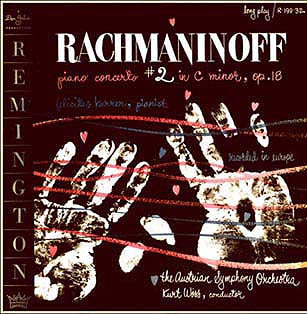
Rachmaninoff:
Concerto No 2 on R-199-32 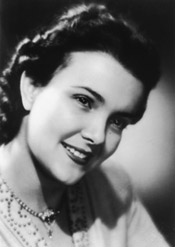
Felicitas
Karrer in the nineteen forties.
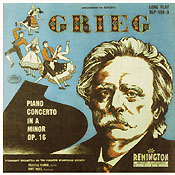
The
early edition of the Grieg Concerto - RLP-199-3 
Rachmaninoff:
Concerto No 2 on the earliest Remington label (RLP-199-32)

The
Plymouth Merit release of Rachmaninoff's Opus 18
(P-12-12).
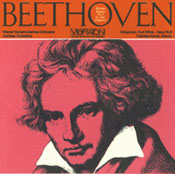
The
release on Vibraton K 2016 of Beethoven's Emperor Concerto performed by pianist
Felicitas Karrer and conductor Kurt Wöss was re-recorded in electronic stereo.

Continental
Records were also released in Canada. The records were issued in a special Great
Composers series. The records were pressed in the Webster plant.

On
label and cover of the Grieg release (GCLP 907) the names of pianist Felicitas
Karrer and conductor Kurt Wöss are omitted. The Austrian Symphony Orchestra
is now the so called Festival Orchestra.

The
cover of the reissue on the Masterseal label of the Grieg Concerto. The picture
is not of Felicitas Karrer, but of a model, and was supplied by the Baldwin Piano
Company. Much later the recording was released on the Masque label (M 10005).


At
the time she recorded for Remington, she also made 78 RPM recordings for the Viennola
label. On P 6064: Chopin (Waltz Op. Posth., Mazurka Op. 7 No. 1 and Waltz Op.
64
No 2). On P 6065: Liszt (Gnomenreigen and Consolation). 

Felicitas
Karrer in 1960 during a televised concert for Austrian Broadcasting Corporation
(ORF). 

|
She
appeared on Remington discs, performing Beethoven, Grieg and Rachmaninoff,
and her records must have found their ways into many households. They
were shelved next to the world famous interpretations of the great Piano
Concertos played by the greats of her time: Dinu Lipatti (Grieg), Rudolf
Serkin (Beethoven), and Arthur Rubinstein (Rachmaninoff).
Or, her records may just have been the affordable alternatives to these
recordings on Columbia and RCA Victor.
Yet
the art of this Viennese pianist, who recorded piano music of Richard
Wagner and Franz Schubert as well, and who is known to have performed
Sergei Bortkiewicz's First Piano Concerto Op. 16 in 1952 with the composer
conducting, was soon forgotten because circumstances changed.
|
|
|
The
cover of Felicitas Karrer's booking brochure from the mid nineteen
fifties with biographical details, quotes from the press, and
the listing of her repertory.
Picture restored and edited by R.A.B.
|
Felicitas
Karrer was born in Vienna on August 26, 1924. Her father was Cesar Karrer
(1886-1963), a well-known technician. He was a "Diplom Ingenieur"
as the official title is, and he played a significant role in the automotive
world in Austria by regulating many issues regarding the position of
garages and their owners.
|
|
|
Cesar
Karrer's Astoria Garage opened in 1938 and is still in full operation
today.
|
He
introduced the daylight garage (Tageslichtgarage), which was a novelty
in the first half of the past century. He built a unique 5 story garage
with space for 400 cars. As he financed the enterprise himself, it took
almost ten years to build it (from 1929 till 1938). Cesar Karrer had two
daughters, Sylvia, who studied to be an architect, and Felicitas, who
studied with Friedrich Wührer
to be a concert pianist.
Already
at the age of 5 Felicitas started to play the piano. And it soon was
discovered that she had absolute pitch, which is of course a blessing
as you will strive for perfection. As a child she gave concerts playing
music of Bach and Telemann. When she was in the 8th grade studying at
the Gymnasium, she simultaneously studied at the 'Hochschule für
Musik' - today 'Universität für Musik und Darstellende Kunst'.
It was from 1941 till 1945 that she studied with Friedrich Wührer
(1900-1975). Felicitas passed the Hochschule exam with flying colors.

Friedrich
Wührer can be found on the Remington label playing Beethoven's
Fourth Piano Concerto with the Austrian Symphony Orchestra conducted
by Karl Randolf on R-199-72.
Friedrich
Wührer was a regular performer in the Musikvereinssaal. He
appeared with many a conductor.
With Eugen Jochum playing „Sinfonia pastorale“ (Franz
Schmidt) in the adaptation for 2 hands by Wührer; Herbert
von Karajan (Rachmaninoff Piano Concerto No. 2); Gustav Koslik
(Brahms Concerto No. 1); Robert Heger; Wolfgang Sawallisch (Beethoven's
Emperor Concerto).Wührer performed in the same recital in
which Clara Haskil played; on the program works by Beethoven,
Schumann, Schubert and Brahms.
On January 6, 1952, he performed Beethoven's Piano Concerto No.
4 with the Niederösterreichisches Tonkünstlerorchester
conducted by Karl Randolf. This led to the recording of the concerto
for the Remington label and may have resulted in a contract with
Vox. - R.A.B.
|
Felicitas
Karrer: "Friedrich Wührer had the best balanced left hand, like only
few pianists have."
She
participated in various contests: Vienna (1948); Paris (1949) Concours
Marguerite Long; Geneva (1951); Munich (1952); Siena (Academia Chigiana
Siena). In Vienna she was awarded when playing the Burlesque of Richard
Strauss with Otto Ackermann conducting. She was the first
pianist to play all six Beethoven Concertos (Triple Concerto included)
in no less than three concerts. That was during the season 1949-1950.
She again played the Triple Concerto in 1952 with violinist Willy
Boskovsky, cellist Emanuel Brabec and conductor Volkmar
Andreae; and the already mentioned performance at the occasion of
the 75th birthday of Sergej Bortkewicz in the Musikvereinssaal,
also in 1952.
Felicitas
Karrer worked
with many conductors: Hans Swarowsky, Robert Heger, Dr. Bernard Paumgartner
(Mozarteum Orchestra), Ernst Märzendorfer (Radio Orchestra Beromünster),
Paul van Kempen (Orchestra del Maggio Fiorentino), Felix Prohaska, Anton
Konrath, Kurt Rapf, Eduard van Remoortel, Karl Randolf (Graz Philharmonic),
and many more. And she performed in Switzerland, Italy, Germany, Belgium
and Great Britain.
|
|
|
Rachmaninoff's
Piano Concerto No. 2 was recorded in May, 1950, and listed for the
first time in Schwann, September 1951 edition, reference number
R-199-32.
|
In
1946  Marcel
Prawy (36) and
Marcel
Prawy (36) and  Hans
Wolf (33), both in US Army uniform, had returned to the devastated
Vienna. The war was over and though the atmosphere looked rather grim,
they had plans for a bright future. Wolf eventually picked up music
making as a conductor and he later decided to go back to the USA and
try his luck there. Prawy started producing records, from 1950 till
January 1953 for Don Gabor's Remington Records based in New York, and
the following years on his own account.
Hans
Wolf (33), both in US Army uniform, had returned to the devastated
Vienna. The war was over and though the atmosphere looked rather grim,
they had plans for a bright future. Wolf eventually picked up music
making as a conductor and he later decided to go back to the USA and
try his luck there. Prawy started producing records, from 1950 till
January 1953 for Don Gabor's Remington Records based in New York, and
the following years on his own account.
In
1950 Prawy and Wolf invited Miss Karrer to record Ludwig van Beethoven's
Op. 75 (Emperor Concerto), the Concerto in A minor, Op. 16 of
Edward Grieg and Sergei Rachmaninoff's Second Concerto in C,
Op. 18, together with Kurt
Wöss conducting the newly formed Tonkünstler Orchestra (Austrian
Symphony), by no means a virtuoso orchestra at the time, but the musicians
were working hard and were gradually achieving better ensemble playing
thanks not only to the individual musicians who wanted to earn a living
as a member of an orchestra, but also thanks to Kurt Wöss who knew
his way around. He had been a student of Felix Weingartner.
|
|
|
Alex
Steinweiss's cover for the recording of Felicitas Karrer's poetic
and strong performance of the Piano Concerto in A minor Op. 16
of Edvard Grieg, with Kurt Wöss conducting the Austrian Symphony
Orchestra - Remington R-199-3.
Cover
of the release on the second label, edited by R.A.B.
|
|
|
Click here
for a Sound Clip of the Second Movement of the Grieg Concerto
|
|
The
performances were recorded "in einem Guss", Felicitas Karrer
said. In plain English: "in one cast". There was no time and
money for an extra rehearsal. Generally splicing was practically out
of the question. Only in case a very big mistake was made a recording
session would be interrupted and would be started again just before
the bad spot.
Although
the recordings bear the marks of that practice, the cooperation between
Felicitas Karrer and Kurt Wöss was exemplary. "Yes, we were
on the same wavelength", Felicitas Karrer said when I mentioned
the good atmosphere in the orchestra and the very idiomatic playing
by both pianist and orchestra in the Grieg Concerto, and with
a remarkable orchestral balance too.
The
Grieg Concerto was recorded in the Wagnersaal (Musikverein) which
has extremely bad acoustics. The piano was placed very close to the
back wall to improve its presence. This recording of the Concerto shows
that this is one of the few performances reminding the listener of the
orchestral writing for Henrik Ibsen's "Peer Gynt" and of the
Lyric Pieces. It also shows how able a conductor Kurt Wöss was
and how Felicitas Karrer at 26 played with ease and concentration. "It
is often played too fast", Felicitas Karrer says, "and then
the pianist drops too many notes from which another concerto could be
constructed", she adds.
The
information about the musicians who performed the Grieg Concerto, printed
on the back of the reissue of the early Remington on Masterseal in 1957,
were probably written for advertising purposes rather than for really
informing the record buyer about the artist and orchestra, but there
is much truth in it:
"The
Viennese Symphonic Orchestra embodies the leading musicians of
Vienna and has won world wide acclaim for its outstanding performances.
Felicitas Karrer, one of Europe's outstanding postwar pianists,
gained rapid fame after the war by concertising throughout Europe.
Her imaginative interpretations of the great piano classics have
gained Miss Karrer a legion of enthusiastic followers who have
established her among the elite of European concert artists.
The combined efforts of Miss Karrer and the Viennese Symphonic
Orchestra under the baton of Kurt Wöss, offers indeed a performance
to be cherished among your musical treasures."
|
Also
the Rachmaninoff C minor Concerto shows how extremely gifted
the pianist is. Despite the order that "nothing shall go wrong",
the performance is transparent, and here too the poetry is fully present.
It is a very sensitive, melodic and romantic performance. Her technique
is excellent and the concept shows grandeur. The listener may also discover
that there are more notes and lines in the piano score which are not
always heard in other performances.
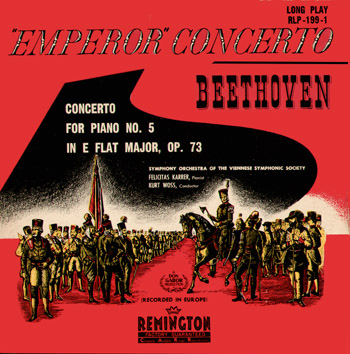
The
Beethoven Emperor gets a clean, translucent and energizing performance,
revealing the logical connection to its predecessor, No. 4, Op. 58,
and is a joy to listen to. There is no excessive weight, nor are there
fashionable ritardandos, rubatos, and there is no restraint in this
magnificent concerto. A recording of a performance Marcel Prawy and
also Donald Gabor could really be proud of. It shows not only good intentions,
but there is also the virtuosity of Felicitas Karrer's playing.
Felicitas
Karrer still remembers the serene beauty of the second movement, although
she has not been able to listen to the records for quite a long time.
In 1964 she married physician Dr. Konrad Kodrnja, originally from Slovenia.
Her husband, with whom she had a very harmonious marriage (he passed
away in 2003), gave every so often a record to an admirer of his Felicitas.
Finally there were no more copies in the house left to listen to.
Both
the Rachmaninoff and Beethoven Concertos were recorded in the Mozartsaal
(Vienna Konzerthaus) which is in fact better suited for chamber music
ensemble playing, but has far better acoustics than the Wagnersaal,
Miss Karrer told me.
|
|
|
Rarely
played and rarely recorded: Wagner's Piano Sonatas and Albumblatt,
in a sensitive performance by Felicitas Karrer on Remington R-199-26,
a disc not to be overlooked.
|
The
Wagner Sonata disc contains seldom performed and seldom recorded
compositions by the young Richard Wagner. They show the influence of
Beethoven and have a touch of Schubert. There is also a more mature
and older Wagner who, in "Eine Sonate in das Album von Frau Mathilde
Wesendonck in A flat major", is foreboding the tragedy of love
in the grand opera of "Tristan und Isolde". Especially this
"Wesendonck Sonata" is played with intensity, sorrow, and
rebellion, much more so by Felicitas Karrer than by younger pianists
in the modern recordings of the nineteen nineties. In High Fidelity
Magazine of April, 1955, James Hinton, Jr. compiled "Wagner on
Microgroove", in which he also evaluated Felicitas Karrer's performance
of the B Flat Piano Sonata.
Aside from the fact that this sonata is an ideal guessing-game piece,
it is quite agreeably pretty. Felicitas Karrer's performance is
musically in the spirit and technically adroit, aside from some
insignificant misfingerings - notably in the final movement, where
Wagner makes a brave little harmonic experiment and Miss Karrer
stubs a thumb. Not the very best piano tone on records, but adequate.
- James Hinton, Jr. (High Fidelity Magazine, April 1955)
|
 Although
Although  Warren
De Motte does review many a Remington recording in "The
Long Playing Record Guide" (Dell Publishing Company, New York,
1955), the performances of the great concertos by Felicitas Karrer are
not mentioned in this reference publication. From the Fall of 1953 on,
Gabor hired the RIAS Symphony Orchestra (Berlin) to make the new and
technically better MUSIRAMA recordings. So it was decided that the earliest
recordings made in Vienna were gradually deleted from the Remington
catalog. In the Spring of 1954 it was announced that Gabor trimmed down
the catalog by 30%. And maybe the popular Grieg, Beethoven and Rachmaninoff
were on the list to be recorded in Berlin as well. If so, new recordings
of these concertos were not made as the contract with Bertelsmann was
prematurely ended. See
Warren
De Motte does review many a Remington recording in "The
Long Playing Record Guide" (Dell Publishing Company, New York,
1955), the performances of the great concertos by Felicitas Karrer are
not mentioned in this reference publication. From the Fall of 1953 on,
Gabor hired the RIAS Symphony Orchestra (Berlin) to make the new and
technically better MUSIRAMA recordings. So it was decided that the earliest
recordings made in Vienna were gradually deleted from the Remington
catalog. In the Spring of 1954 it was announced that Gabor trimmed down
the catalog by 30%. And maybe the popular Grieg, Beethoven and Rachmaninoff
were on the list to be recorded in Berlin as well. If so, new recordings
of these concertos were not made as the contract with Bertelsmann was
prematurely ended. See  RIAS Symphony Orchestra.
RIAS Symphony Orchestra.
Despite
the low technical recording quality of the Rachmaninoff Concerto, one
has to admit that the recorded performance of this concerto (and of
the other other concertos for that matter) by Felicitas Karrer and Kurt
Wöss do have the ingredients for some good music making. When I
sent a copy of the Grieg Concerto on CD to Mrs. Karrer, she told me:
"I quite like the performance of this Concerto. I did not know
it was that good."
If
Warren DeMotte did not make note of these in his Long Playing Record
Guide, it was G.C. Burke who did review Felicitas Karrer's Beethoven
Emperor and included it in his Beethoven discography in the spring of
1952. The other contestants were Victor Schioler (Mercury 10060), Artur
Schnabel (RCA Victor LCT 1015), Rudolf Serkin (Columbia ML 4373), and
Clifford Curzon (London LLP 114 38). In High Fidelity Magazine, Vol.
1, No. 4, of 1951, Burke wrote:
"Schioler-Garaguly
tempers the Emperor's might with delicacy, not unpleasantly, in
an honest and cohesive recording not less meritorious for being
unsensational. Either this or Schnabel-Stock seems to be the best
of these recorded Emperors, although Karrer-Wöss (whoever
they are) have given us, curiously the stateliest of the five
concepts. Miss Karrer has a musical dignity somewhat above the
limits of her strength but she and Wöss mingle the serene
majesty of their exposition with a complicating sense of human
friendliness, of uncustomary appeal." - G.C.
Burke
(High Fidelity Magazine No. 4, 1951)
|
Burke
remarked "who ever they are" meaning that the names of the
artists were not only unknown but were probably considered pseudonyms.
Felicitas
Karrer's repertory encompassed not just Beethoven, Grieg, Rachmaninoff,
and Wagner, but also Brahms (Piano Concerto No. 1, Op. 15), music
of Belgian composer Jean Absil (Concerto Op. 30), Benjamin
Britten (Piano Concerto), César Franck (Symphonic Variations),
Manuel de Falla (Nights in the Gardens of Spain), Concertos
of Mozart (K414, 449, 459, 466, 537), Sergei Prokofiev's First Concerto
Op.10, Carl Maria von Weber's "Konzertstück" and Concerto
No 2 in E-flat Major, Mussorgski's "Pictures at an Exhibition",
and Franz Schmidt's Piano Concerto in E flat major, as well as the
"Konzertante Variationen" on a Beethoven theme (Concertante
Variations on a Theme of Beethoven for piano-left hand and orchestra)
of this remarkable composer.
What
did the papers say about her live performances?
The
critic of "Neues Oesterreich" of May 27, 1950, wrote
about the performance of Beethoven's Emperor Concerto:
"Her touch is well graded and well controlled, and sufficient
to master the double octaves in the first movement as well as
the warm cantilene of the Adagio where she knows how to produce
the rich tone needed to sustain the long, drawn out phrases.
(...) Her strong musical temperament is fanned into life by
the uncanny Beethovenian humor of the sparkling Rondo finale.
Her technical perfection combined with true feeling places her
in the front rank of our young pianists"
After
performing in Brussels, "Le soir" wrote on May 11,
1953:
"In Pictures at an Exhibition her playing was brilliant,
animated and suggestive."
Famous
composer, teacher and performer Joseph Marx wrote in "Wiener
Zeitung" of February 25, 1951:
"Felicitas Karrer, one of our most gifted pianists, gave
proof of her merits in the glittering figurative passages of
Mozart's Piano Concerto in F Major."
|
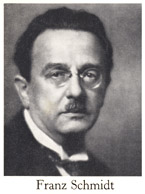 Paul
Wittgenstein (1887, Vienna - 1961, New York) who was severely wounded
in the First World War and had only command of his left hand, had asked
Austrian Composer Franz Schmidt (1874-1939) to write Concertos for the
left hand for him to be performed. These concertos were extremely difficult
to play (as was the Concerto for the Left Hand written for Wittgenstein
by Maurice Ravel). It was Felicitas Karrer's teacher, Friedrich Wührer,
who rewrote the solo parts of the Concerto and of the Variations for
the execution with two hands. Both were also on Felicitas Karrer's long
list. Paul
Wittgenstein (1887, Vienna - 1961, New York) who was severely wounded
in the First World War and had only command of his left hand, had asked
Austrian Composer Franz Schmidt (1874-1939) to write Concertos for the
left hand for him to be performed. These concertos were extremely difficult
to play (as was the Concerto for the Left Hand written for Wittgenstein
by Maurice Ravel). It was Felicitas Karrer's teacher, Friedrich Wührer,
who rewrote the solo parts of the Concerto and of the Variations for
the execution with two hands. Both were also on Felicitas Karrer's long
list.
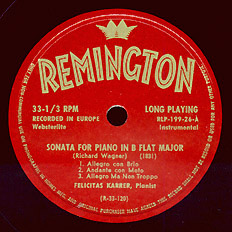 Her
style was often compared to that of Monique Haas. Her
style was often compared to that of Monique Haas.
Felicitas also loved to play "Paganini Rhapsody", Rachmaninoff's
Op. 43, of which she gave the première performance in Austria.
She played Aram Khatchaturian's Piano Concerto with the composer conducting,
a work she also liked very much. The Khatchaturian concerto too asks
for firm and decisive playing. Therefore she was also referred to as
"the female Gulda", putting her in the same league as Friedrich
Gulda because of the sensitivity and firm intention as well.
With
such a repertory and style - which matured even further during the years
- one wonders why the recordings of Felicitas Karrer are few. Under
the title "Piano Encores" (Remington R-149-4), various
pianists play short compositions. She plays "Valses nobles",
Schubert's Opus 77. The other pianists on that ten inch disc are Alexander
Jenner (Chopin), Jörg Demus (Bach), and Alfred Kitchin (Mozart).
Apart
from her Remington recordings which were listed in Schwann Record Catalog
until 1958, she also appeared on the Viennola label from Vienna
on which she plays compositions of Schubert, Brahms, Chopin, and
Liszt, reference number 1015.
A
decisive occurrence in her personal life and her professional career
was that she was in a car accident in 1958 and suffered a severe concussion
which forced her to follow a less intensive program of studying and
performing for some time.
She
also performed with Wolfgang Sawallisch conducting, and at one
time she was a candidate to record with Willem van Otterloo and
the Hague Philharmonic (Residency) Orchestra instead of Clara Haskil,
and she played for Herbert von Karajan, met numerous musicians
among which pianist Aldo Ciccolini, conductor Zoltan Fekete,
and she knew violinists Wolfgang Schneiderhan and his brother
 Walter
Schneiderhan (who was concert master of the Vienna Symphony).
In fact she knew many well known artists of the nineteen forties, fifties
and sixties. And there were many in Vienna. Each of them felt some competition
at one time or another when another artist was chosen to perform, like
Edith Farnadi instead of Felicitas Karrer.
Walter
Schneiderhan (who was concert master of the Vienna Symphony).
In fact she knew many well known artists of the nineteen forties, fifties
and sixties. And there were many in Vienna. Each of them felt some competition
at one time or another when another artist was chosen to perform, like
Edith Farnadi instead of Felicitas Karrer.
Like
so many artists she also has known the dilemma of following a career
which asks for complete dedication and which is often to the detriment
of a full, personal life. When she married she stopped altogether with
a demanding concert schedule. Felicitas Kodrnja Karrer: "It is either
your marriage or your career that is going to suffer." She chose for
a rich personal life. Did she ever teach the piano to the younger generation?
Felicitas: "No", she said, "it is like Wilhelm Backhaus said:
I am my own best pupil."
Mrs.
Karrer still follows the scene from the sideline and mentions Martha
Argerich and Yevgeny Kissin as outstanding. She also finds that nowadays
many pianists do play often too fast and do not create the right atmosphere
of the work.
Today Felicitas Karrer is still in charge of the 5 story garage her
father had finished building in 1939.
The
Remington recordings of Felicitas Karrer:
R-199-1
Ludwig van Beethoven: Emperor Concerto with  Kurt
Wöss conducting the Austrian Symphony Orchestra.(Released
in 1950) (Plymouth P-12-11.) Billboard Magazine of October 14, 1950
reviewed Remington R-199-1
Kurt
Wöss conducting the Austrian Symphony Orchestra.(Released
in 1950) (Plymouth P-12-11.) Billboard Magazine of October 14, 1950
reviewed Remington R-199-1
Priced
at $1.99, this waxing of the "Emperor" is an excellent
buy. The performance is more than credible; soloist Felicitas
Karrer delivers a penetrating, sympathetic keyboard job; the ork
is up to snuff. The recording too is alive, clear and excellently
balanced between piano and ork. On the minus side there's an inescapable
surface hiss on the review copy at hand. Whether this is a quality
of "Websterlite", the Remington plastic or only an accident
is a question; other recordings in the Remington low-priced LP
series have considerably less hiss than the one under discussion.-
Billboard October 14, 1950
|
|
|
The
second release of Beethoven's Emperor Concerto.
|
R-199-3
Edvard Grieg:
Piano Concerto in a minor Op. 16, with Kurt Wöss (Released 1950.)
The Masterseal release of the same recording was pressed from Remington
plates, first with the Masterseal label and later with the Remington
Musirama label, but without a reference number. (Plymouth P-12-10).
And the same recording appeared on Gabor's label Masque (ref. M 10005).
Recorded on Tuesday, June 27th, 1950 in the Wagner-Saal.
R-149-4
Franz Schubert: "Valses nobles". Op. 77 (coupled with
Alexander Jenner (Chopin), Jörg Demus (Bach), and Alfred Kitchin
(Mozart). The "Valses sentimentales and nobles" were later
released on the Masque label, then coupled with Demus playing 'Moments
musicaux'. Masque M 10.002.

R-199-26
Richard Wagner: Album Sonata in A Flat Major, Albumblatt in E
Flat Major, Sonata in B Flat Major. (Released 1951.) The Piano Sonata
in B Flat Major can also be found on the Music Plus MP-100-9 release
together with Wagner Arias, with an introduction by  Sigmund
Spaeth.
Sigmund
Spaeth.
|
|
The
Concerteum CR-212 release in France of the Rachmaninoff recording
writes the name of Kurt Wöss as Kurt Woos, so it will be
pronounced more or less correct. |
R-199-32
Sergei Rachmaninoff:
Piano Concerto No. 2 in c minor with the Austrian Symphony Orchestra,
Kurt Wöss conducting, released in 1951, and later also on Plymouth
P-12-12. The first movement can also be found on Twilight Concert
No. 2, catalog number R-199-115.
Text, original
research, and concept (c) Rudolf A. Bruil.
Page first published
August 29, 2007.
|